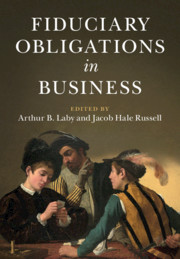Book contents
- Fiduciary Obligations in Business
- Fiduciary Obligations in Business
- Copyright page
- Dedication
- Contents
- Contributors
- Editors’ Acknowledgments
- Introduction The Decline and Rise of Fiduciary Obligations in Business
- Part I Identifying Fiduciaries and Their Duties
- Part II Gaps and Alternatives in Fiduciary Regimes
- 6 Conflicts of Interest in Investment Advice: An Expanded View
- 7 A System of Fiduciary Protections for Mutual Funds
- 8 Equitable Duty: Regulating Corporate Transactions in the Vicinity of Insolvency from a Comparative Perspective
- 9 Equity, Majoritarian Governance, and the Oppression Remedy
- 10 Fiduciary Relationships in Employee Benefit Plans
- Part III Historical and Comparative Perspectives
- Part IV Stakeholders and Society
- Index
6 - Conflicts of Interest in Investment Advice: An Expanded View
from Part II - Gaps and Alternatives in Fiduciary Regimes
Published online by Cambridge University Press: 20 August 2021
- Fiduciary Obligations in Business
- Fiduciary Obligations in Business
- Copyright page
- Dedication
- Contents
- Contributors
- Editors’ Acknowledgments
- Introduction The Decline and Rise of Fiduciary Obligations in Business
- Part I Identifying Fiduciaries and Their Duties
- Part II Gaps and Alternatives in Fiduciary Regimes
- 6 Conflicts of Interest in Investment Advice: An Expanded View
- 7 A System of Fiduciary Protections for Mutual Funds
- 8 Equitable Duty: Regulating Corporate Transactions in the Vicinity of Insolvency from a Comparative Perspective
- 9 Equity, Majoritarian Governance, and the Oppression Remedy
- 10 Fiduciary Relationships in Employee Benefit Plans
- Part III Historical and Comparative Perspectives
- Part IV Stakeholders and Society
- Index
Summary
Financial firms that offer investment advice to retail clients are beset by conflicts of interest: they may receive compensation tied to particular products, operate the financial products themselves, or be subject to other distortions. Regulators and lawmakers have looked to fiduciary and quasi-fiduciary duties to mitigate these conflicts. The paradigmatic example is the rigorous fiduciary standard imposed on registered investment advisers, but the Department of Labor’s now-defunct fiduciary rule, and the Securities and Exchange Commission’s recently adopted Regulation Best Interest similarly aim to mitigate problematic conflicts by imposing duties on those giving investment advice. These interventions largely focus on conflicts affecting which investment products investors are advised to hold, but other types of distortions, less discussed, may be just as important. This chapter offers an expanded account of conflicts of interest, how conflicts might interact, and how the fiduciary rule and Regulation Best Interest should be evaluated in light of this expanded menu of problematic incentives.
Keywords
- Type
- Chapter
- Information
- Fiduciary Obligations in Business , pp. 113 - 131Publisher: Cambridge University PressPrint publication year: 2021



